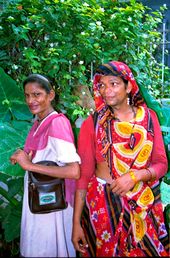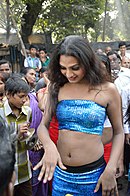Hijra (South Asia)
![]()
This article is about the third gender - for the Islamic flight, see Hijra.
Hijra or hijra is a South Asian term for transgender or intersex people in India, Pakistan, and Bangladesh, some of whom are eunuchs by choice. Hijras are officially recognized as a third gender in several South Asian countries, where they are considered neither fully male nor fully female.
The term "hijra" is a Hindi Urdu word derived from the Semitic Arabic root hjr* meaning "to break with, abandon, desert, cast out, emigrate, flee". The Indian use of the word hijra has traditionally been translated into English as eunuch (eunuch) or hermaphrodite (hermaphrodite), where "the irregularity of the male genitalia is central to the definition."
Hijra are also known as Aravani, Aruvani or Jagappa. In many languages of India, especially outside northwest India, other terms such as "chhakka" are used. Hijras have been historically recorded in the Indian subcontinent since ancient times, for example in the Kama Sutra (from 200 AD).
Many hijras live in well-defined and organized living and economic communities, led by a guru-mother. The most important relationship in the hijra community is that of guru (master, teacher) and chela (disciple). A guru-mother must provide for the material and spiritual needs of her disciples and is entitled to loyalty and a share of her income in return.
These communities have sustained themselves for generations through the "adoption" of biologically male adolescents or children who have been rejected by their family of origin and others for their feminine behavior and flee to the hijras to live fully their feminine gender identity, or who live in abject poverty, sometimes after a period of homosexual prostitution. Many hijra work as sex workers for their survival.
Few hijras, however, are born intersex. Most are born physically male, but many have a female gender identity in the sense of transsexuality or other transgender forms. It is not uncommon for them to undergo total castration called nirwaan, often at a young age, to prevent further masculinization of their bodies. They live as women, and some hijras achieve significant feminization through such an operation.
Linguistically, hijras usually describe themselves as female, as transsexual or even as transgender and dress accordingly. Nevertheless, the conservative outside world often refers to them as eunuchs or "castrated men".
Since the late 20th century, some hijra activists and Western non-governmental organizations (NGOs) have lobbied for official recognition of the hijra as a kind of third gender or third gender identity, as neither male nor female.
In India, the Hijras were recognized as the third gender in 2009, and in Pakistan in 2011, where they were regionally referred to as Khusra. This made Hijras the only officially recognized third gender in the world that year. In Bangladesh, hijras were granted recognition in 2013 and have since enjoyed preferential treatment in education. In India, all hijras, as well as transgender people, eunuchs and intersex people, were recognized as a third gender by the Supreme Court in April 2014. Nepal recognised the legal existence of a third gender in 2015 and - like India - allows a corresponding gender entry in official documents; there, in addition to some hijras, there are also meti and kothi (see also Divers as well as countries with a third gender entry).

The Hindu deity Shiva in bisexual form as Ardhanarishvara
Terminology
The Urdu and Hindi word hijra ([ˈɦɪdʒɽaː]; also hijira, hijda, hijada, hijara, hijrah) is generally understood in Urdu to mean derogatory, disdainful, contemptuous; the term Khwaja Sara is used instead. Another term is khasuaa (खसुआ) or khusaraa (खुसरा). The synonym for hijra in Bengali is হিজড়া, hijra, hijla, hijre, hizra, or hizre. A whole range of terms in the culturally and linguistically diverse Indian subcontinent denote similar gender categories, which can basically be considered synonyms, depending on regional cultural differences. In Odia, a hijra is referred to as hinjida, hinjda or napunsaka, in Telugu as napunsakudu (నపుంసకుడు), kojja (కొజ్జ) or maada (మాడ), in Tamil Nadu as thiru nangai ("mister woman"), ali, aravanni, aravani, or aruvani, in Punjabi as khusra and jankha, in Sindhi as khadra, in Gujarati as pavaiyaa (પાવૈયા). In North India, the goddess Bahuchara Mata is worshipped by Pavaiyaa (પાવૈયા). In South India, the Goddess Renuka, is believed to have the power to change the gender of a person. Male born devotees in female attire are known as Jogappa. They perform similar social roles as Hijra, such as dancing and singing at birth ceremonies and weddings. The word kothi (or koti) is also common in India, similar to the kathoey of Thailand, although kothis are often distinguished from hijras. Kothis are considered effeminate men or boys who take the feminine role in having sex with men, but they do not live in the kind of communities that hijras do. Also, not all kothis have taken initiation rites or gender-altering steps to become a hijra. Local equivalents are: durani (Kolkata), menaka (Cochin), meti (Nepal), and zenana (Pakistan).
"Hijra" was and is translated in English as "eunuch" (eunuch) or "hermaphrodite" (hermaphrodite), but LGBT historians or human rights activists have already tried to classify her as transgender. However, in a series of meetings of the Transgender Experts Committee of India's Ministry of Social Justice and Empowerment between October 2013 and January 2014, Hijra and other trans activists demanded that the term "eunuch" be removed from use in government documents, as the Hijra community does not identify with this term.

Hijras from the Panscheel Park in New Delhi, 1994
Gender identity and sexuality
Hijra identities have no exact counterpart in the modern Western understanding of gender identity and sexual orientation, and pose a challenge to Western notions. While joining a Hijra community is almost inevitable for many trans women and girls and those born intersex, it also has strong religious overtones. Hijra are not always synonymous with Western trans women. More modern developments influenced by the West also lead to the fact that gender reassignment measures such as hormone therapies and operations are desired also for transsexual Hijras who feel as women, although they are often difficult or impossible to reach due to poverty; transsexual Indian women from richer castes do not necessarily enter the Hijra community today, but have gender reassignment according to the Western model despite the social rejection and live a normal life as women.
In India, some hijras do not define themselves by a particular sexual orientation, but rather by rejecting sexuality in general. Sexual energy is transformed into sacred (holy) powers. However, these ideas can conflict with the practice that hijras often work as prostitutes. In addition, effeminate men who take the "receptive" role in sex with a man are often referred to as kothi (or a local equivalent). Kothis are usually distinguished from hijras as having a separate gender identity, often dressing as women and acting in a feminine manner in public and using feminine language in relation to themselves and each other.
The usual partners of hijras and kothis are men who consider themselves heterosexual because they take the male role in sex. These male partners are often married, and any relationship or sex with kothis or hijras is usually kept secret from society. Some hijras enter into committed relationships with men and even marry, although these marriages are usually not recognized by law or religion. Hijras and kothis often have a special name for male romantic or sexual partners, for example panthi in Bangladesh, giriya in Delhi or sridhar in Cochin.

Transsexual hijra (or kothi?) at Chhath Festival, Strand Road, Kolkata, November 9, 2013.

Hijra from Panscheel Park, New Delhi, 1994
Search within the encyclopedia